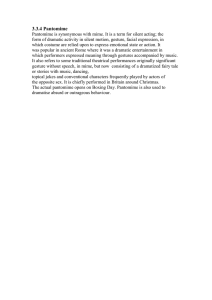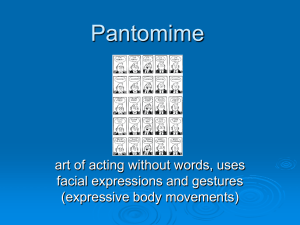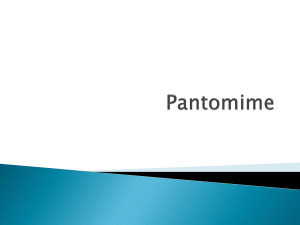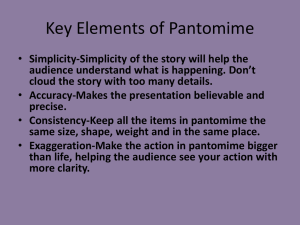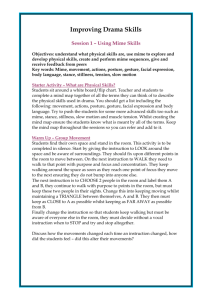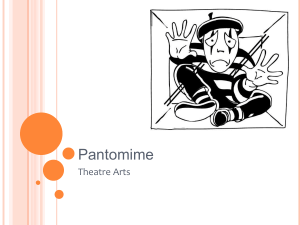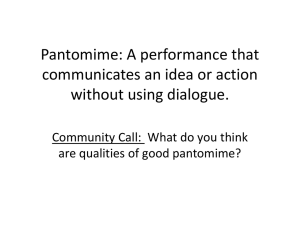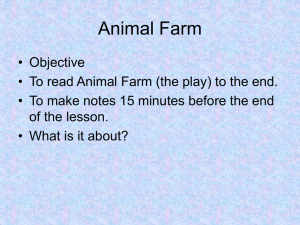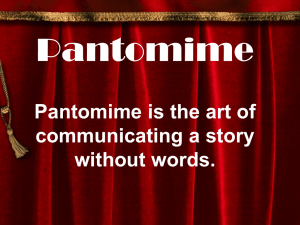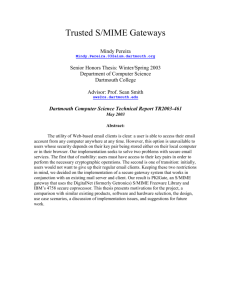Chapter 2 Notes
advertisement
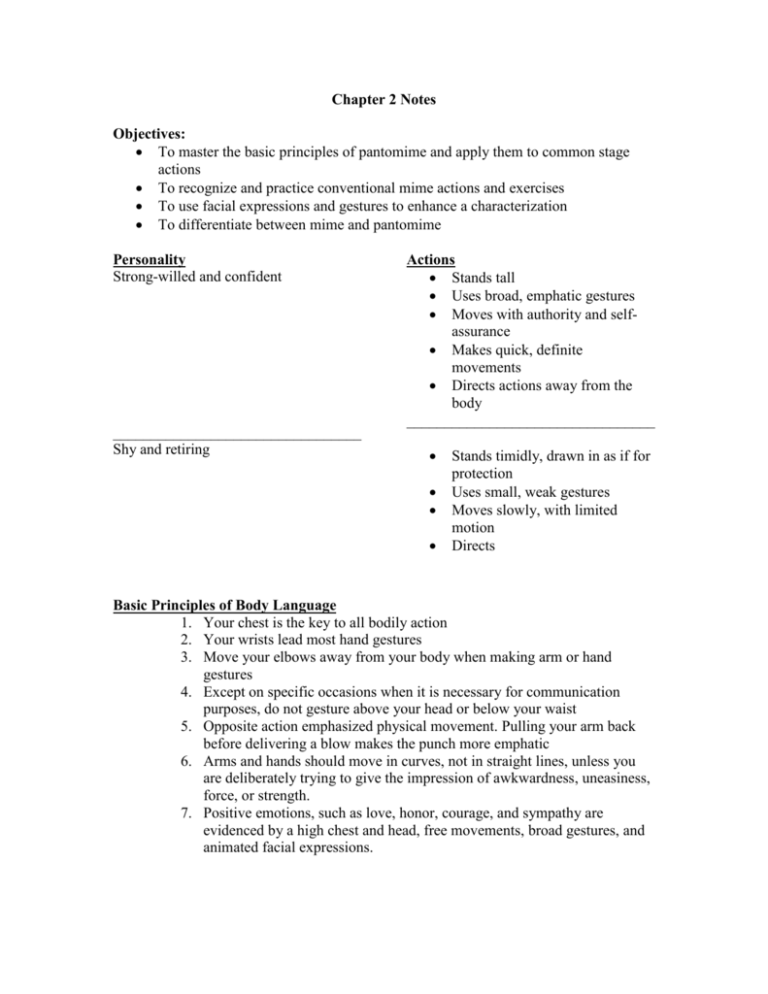
Chapter 2 Notes Objectives: To master the basic principles of pantomime and apply them to common stage actions To recognize and practice conventional mime actions and exercises To use facial expressions and gestures to enhance a characterization To differentiate between mime and pantomime Personality Strong-willed and confident _________________________________ Shy and retiring Actions Stands tall Uses broad, emphatic gestures Moves with authority and selfassurance Makes quick, definite movements Directs actions away from the body _________________________________ Stands timidly, drawn in as if for protection Uses small, weak gestures Moves slowly, with limited motion Directs Basic Principles of Body Language 1. Your chest is the key to all bodily action 2. Your wrists lead most hand gestures 3. Move your elbows away from your body when making arm or hand gestures 4. Except on specific occasions when it is necessary for communication purposes, do not gesture above your head or below your waist 5. Opposite action emphasized physical movement. Pulling your arm back before delivering a blow makes the punch more emphatic 6. Arms and hands should move in curves, not in straight lines, unless you are deliberately trying to give the impression of awkwardness, uneasiness, force, or strength. 7. Positive emotions, such as love, honor, courage, and sympathy are evidenced by a high chest and head, free movements, broad gestures, and animated facial expressions. 8. Negative emotions, such as hate, greed, fear, and suffering, contract and twist the body and are evidenced by a sunken chest, tense movement, restricted gestures, and drawn features. 9. Facial expression – the use of the eyes, eyebrows, and mouth – usually precede other physical actions 10. Whenever possible, make all gestures with your upstage arm, the one away from the audience, and avoid covering your face. 11. Some exaggeration of movement is often essential 12. Always keep the audience in mind, and direct your actions to them 13. All actions must be definite in concept and execution, and all movements must be clearly motivated 14. . How to Develop a Pantomime 1. Decide if you will begin your pantomime on stage in a neutral position – head down or looking straight ahead (upstage or downstage), arms down, hands folded in front- or if you will enter from the wings 2. Set your mental image in detail. Know exactly how much space you will use, the location of the furniture, and the shape, weight, and position of every imaginary prop you will be using. You must remember not to break the illusion by shifting an object without clear motivation and action. 3. Visualize the appearance and emotional state of your character in minute detail. 4. Imagine yourself dressed in the clothes of your character. Make your audience see the weight, shape, and material of each garment. 5. Remember that in all dramatic work, the thought comes first; think, see, and feel before you move. Let your eyes respond first, then your face and head, your chest, and finally, the rest of your body. This is a motivated sequence. 6. Keep your actions simple and clear. 7. Always have a key action early in the pantomime that establishes who you are and what your are doing. Pantomime should not be a guessing game. 8. Keep every movement and expression visible to your entire audience at all times. Place as many imaginary tables, shelves and props as you can in front of you, and face the audience 9. Never make a movement or gesture without a reason. Ask yourself, “Does this movement or gesture clarify who my character is, how he or she feels, or why he or she feels this way?” 10. Practice and analyze every movement and gesture until you are satisfied that it is the most truthful, effective and direct means of expressing your idea or feeling. 11. Make only one gesture or movement at a time, but coordinate your entire body with it, and focus the attention of the audience on it. 12. Rehearse until you are sure that your have created a clear characterization and that the action began definitely, remained clear throughout, and came to a conclusion. 13. Plan you introduction carefully. It may be humorous or serious, but it must arouse interest in your character and in the situation in which your character is place. It must also establish all of the essential details of the setting. 14. Plan the ending carefully. Leave the stage in character. Pantomime The action conveys only action; for example, flying a kite Mime The action conveys the theme, for example, snagging a kite on a tree after struggling to get it soaring in the sky might be a mime’s way of saying, “Our aspirations often become entangled with the things of this word.” The artist works with imaginary objects The artist works with imaginary objects but may also use part of all of the body to become an object or express an idea No sounds are used Nonverbal sounds, such as escaping air, a telephone busy signal, or the screech of tires may be used All pantomimes are based on reality Mimes go beyond reality; they are not limited to the real world The main goal is the exact pantomime of a specific action The main goal is the expression of an idea; themes can often be expressed in simple terms: loneliness, young dreams or forgiveness Definitions 1. “Click”: the setting up of an action with definite hand movements; for example, the snap of a mime’s hand around a glass 2. Anger: the emotion conveyed when the eyes narrow, brows furrow, and jaw sets firmly 3. Charlie Chaplin: a silent film star who was a master of pantomime 4. Chest: the body part where most movements begin 5. Combination: a mime device that uses inclinations, rotations and isolations in one exercise 6. Cross: to move from one place to another onstage 7. Eyes: one of the body parts most mimes emphasize with makeup 8. Fingertips: the body parts where all arm movements must end 9. Gesture: hand and arm movements and facial expressions that help express an idea or an emotion 10. Happiness: the emotion conveyed when eyes squint, brows lift, and mouth curves upward 11. Illusory walk: a basic mime convention; the mime uses exaggerated movement to appear to be walking 12. Inclination: the bending of the body to the front, side, or the rear 13. Isolation: the separation of parts of the body for individual development and expression 14. Kinesthesis: the neuromuscular awareness that you fell when your body is in a particular position 15. Marcel Marceau: The Frenchman who is one of the best-known mimes in history 16. Mime: the art form that does not precisely imitate real-life physical action but gives an illusion of that action 17. Mummenschanz: the Swiss-trained mime troupe that initiated the use of special props and nontraditional objects in mime 18. Nonverbal communication: The general term for expressing ideas and emotions without using words; the essence of pantomime and mime 19. Pantomime: the art of imitating real-life actions without using words 20. Preparatory action: a movement opposite to the action to that the mime wants the audience to follow 21. Relaxation: a combination of inner composure, mental awareness, and physical flexibility; the act of “letting go all over” 22. Resistance: a term for the firmness or solidity of an object in opposition to outside force 23. Rotation: the turning of pivoting of a part of the body, such as the head or the chest 24. Sadness: the emotion conveyed when the eyes narrow, outer brows and mouth turn downward, and facial muscles sag 25. Surprise: the emotion conveyed when eyes widen, brows lift, and mouth forms the shape of an O
